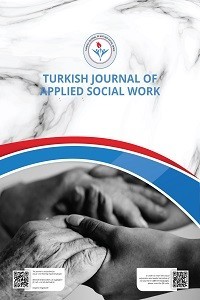PHYSICALLY DISABLED ADULTS IN TURKEY DURING THE COVID-19 OUTBREAK: A PHENOMENOLOGICAL RESEARCH ON THE EXPERIENCES OF PEOPLE WITH SPINAL CORD INJURY
PHYSICALLY DISABLED ADULTS IN TURKEY DURING THE COVID-19 OUTBREAK: A PHENOMENOLOGICAL RESEARCH ON THE EXPERIENCES OF PEOPLE WITH SPINAL CORD INJURY
This study aims to explore the main problems that individuals with SCI encounter in daily life during the COVID-19 outbreak in Turkey based on their own experiences. A field study in phenomenological research design is planned for this purpose. In this article, in accordance with the themes determined for the research, the experiences of 19 adult individuals with SCI and 4 caregivers living in Istanbul are conveyed. The key findings were evaluated with thematic analysis within the framework of the main problematic of "The main problems that individuals with SCI face in daily life during the COVID-19 pandemic". The main themes of the research are determined as impact COVID-19 on daily life, access to health, rehabilitation and social services, and their participation in social life. When the findings obtained from the research are evaluated, the most significant problems that the participants encountered during the COVID-19 pandemic are found as: 1. Stress, fear, and anxiety about infection and transmission of the virus, 2. Deprivation from proper care and treatment for their secondary health conditions, 3. Economic difficulties caused by unemployment, loss of income and increasing costs, 4. Difficulties because of the interruption of rehabilitation and care services, 5. Changes in daily routine such as eating and sleeping patterns, leisure activities; communicational and psychological problems, 6. Difficulties in following current information about public health. The COVID pandemic has deepened the problems people with SCI that they encounter in social life and about social support, and increased their dependence on someone. Considering that the epidemic continue and can occur again, there is a need for new multidisciplinary studies on the social services and social support models that can be applied in the pandemic for people with SCI and their families.
Keywords:
covid19 spinal cord injuries, disabled peoples, social services,
___
- Barclay, L., McDonald, R. and Lentin, P. (2015). Social and Community Participation Following Spinal Cord Injury: A Critical Review. International Journal of Rehabilitation Research, 38 (1), 1-19. doi:10.1097/MRR.0000000000000085.
- Barclay, L., McDonald, R., Lentin, P., & Bourke-Taylor, H. (2015). Facilitators and barriers to social and community participation following spinal cord injury. Australian Occupational Therapy Journal, 63(1), 19-28. doi:10.1111/1440-1630.12241
- Campbell, V. A., Gilyard, J. A., Sinclair, L., Sternberg, T., & Kailes, J. I. (2009). Preparing for and Responding to Pandemic Influenza: Implications for People With Disabilities. American Journal of Public Health, 99(S2), S294-S300. doi:10.2105/ajph.2009.162677
- Creswell, J. W. (2012). Qualitative Inquiry and Research Design: Choosing Among Five Approaches. CA: Sage.
- Çelik, H. D. (2006). Omurilik Felçlilerinde Engellilik Durumunun ve Yaşam Kalitesinin Değerlendirilmesi. Yayınlanmamış Uzmanlık Tezi. Şişli Etfal Eğitim ve Araştırma Hastanesi, İstanbul.
- Keleher, C. A., Dixon, D. R., Holliman D. & Vodde, R. (2003) Spinal Cord Injury, Journal of Social Work in Disability & Rehabilitation, 2(1), 57-77. DOI: 10.1300/J198v02n01_04
- Korupolu R, Stampas A, Gibbons C, Hernandez Jimenez I, Skelton F, Verduzco-Gutierrez M. (2020). COVID-19: Screening and Triage Challenges in People with Disability due to Spinal Cord Injury. Spinal Cord Series Cases, 6(35) https://doi.org/10.1038/s41394-020-0284-7
- Matter, B., Feinberg, M., Schomer, K., Harniss, M., Brown, P., & Johnson, K. (2009). Information Needs of People With Spinal Cord Injuries. The Journal of Spinal Cord Medicine, 32(5), 545–554. doi:10.1080/10790268.2009.11754556
- Müller, R., Peter, C., Cieza, A., & Geyh, S. (2012). The role of social support and social skills in people with spinal cord injury--a systematic review of the literature. Spinal cord, 50(2), 94–106. https://doi.org/10.1038/sc.2011.116
- National Disability Institute (2020). COVID-19 Disability Community Survey Results: Health and Financial Crisis. https://www.nationaldisabilityinstitute.org/wp-content/uploads/2020/04/findings-from-covid-survey.pdf (Accessed: 23.07.2020)
- O’Connell, C.M., Eriks-Hoogland, I. & Middleton, J.W. (2020). Now, more than ever, our community is needed: spinal cord injury care during a global pandemic. Spinal Cord Ser Cases 6, 18. https://doi.org/10.1038/s41394-020-0270-0
- O'Sullivan, T., & Bourgoin, M. (2011). Vulnerability in an Influenza Pandemic: Looking beyond medical risk, October 2010. White Paper Funded by Public Health Agency of Canada. https://homelesshub.ca/sites/default/files/Lit%20Review%20-%20Vulnerability%20in%20Pandemic_FINAL.pdf (Accessed: 11.04.2021)
- Russell, H. F., Richardson, E. J., Bombardier, C. H., Dixon, T. M., Huston, T. A., Rose, J., Ullrich, P. M. (2015). Professional standards of practice for psychologists, social workers, and counselors in SCI rehabilitation. The Journal of Spinal Cord Medicine, 39(2), 127-145. doi:10.1080/10790268.2015.1119966
- Stillman, M.D., Capron, M., Alexander, M. et al. (2020). COVID-19 and spinal cord injury and disease: results of an international survey. Spinal Cord Ser Cases 6, 21 https://doi.org/10.1038/s41394-020-0275-8
- The Asian Spinal Cord Network (2015) Psychosocial Guıdelines in Spinal Cord Injury Rehabilitation. https://ascon.info/wp-content/uploads/2018/05/psychosocial-guidelines15.pdf (20.04.2021)
- Thelwall, M.& Levitt, J. M. (2020). Retweeting Covid-19 Disability Issues: Risks, Support and Outrage. El Profesional De La Información, 29 (2), e290216. https://doi.org/10.3145/epi.2020.mar.16
- Williams, R.&Murray, A. (2015). Prevalence of Depression After Spinal Cord Injury: A Meta-Analysis. Archives of Physical Medicine and Rehabilitation, 96(1), 133–140. doi:10.1016/j.apmr.2014.08.016
- WHO (2011). World Report on Disability. https://www.who.int/publications/i/item/WHO-NMH-VIP-11.01 (Accessed: 05.02.2021)
- WHO (2013a). International Perspectives on Spinal Cord Injury. http://apps.who.int/iris/bitstream/handle/10665/94190/9789241564663_eng.pdf?sequence=1 (Accessed: 12.02.2021)
- WHO (2013b). Spinal Cord Injury. https://www.who.int/news-room/fact-sheets/detail/spinal-cord-injury (Accessed: 05.02.2021)
- Yıldırım, A.&Şimsek, H. (2011). Sosyal Bilimlerde Nitel Araştırma Yöntemleri. Ankara: Seçkin Yayınevi.
- ISSN: 2651-4923
- Başlangıç: 2018
- Yayıncı: Mehmet Zafer DANIŞ
Sayıdaki Diğer Makaleler
THE STATISTICAL DATA OF FEMICIDE IN THE WORLD AND TURKEY DOES REFLECT THE TRUTH?
THE RELATIONSHIP BETWEEN SOCIAL WORK ACADEMIC DISCIPLINE-OCCUPATION AND DEMOCRACY
A DEMOGRAPHIC STUDY ON SYRIANS UNDER TEMPORARY PROTECTION: THE CASE OF ANKARA
Gülcan URHAN, İnci KAYIN, İsmail NALBANTOĞLU
A COMMUNITY-BASED RISK REDUCTION AND RECOVERY PROGRAM; A MODEL FOR THE SYRIAN REFUGEE CRISIS
